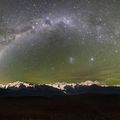Moonrise Symphony
Im Halbdunkel der anbrechenden Nacht, etwa 45 Minuten nach Sonnenuntergang, nimmt der Himmel eine zwielichtige tiefblaue Farbe an. Grund dafür ist die Ozonschicht, die beim parallel durch die hohe Atmosphäre fallenden Restlicht wie ein Farbfilter wirkt und nur den blauen Lichtanteil übrig lässt. Der aufgehende Mond beleuchtet die Berge und in tiefster Ruhe werden die ersten Sterne sichtbar. Die Gesteine, die das Panorama des bis zu 4810 m hohen Mt. Blanc Massivs in den französischen Alpen aufbauen, haben eine geologische Geschichte, die bis in das Zeitalter des Karbon und Perm vor 300 Millionen Jahren zurück reicht. Zu dieser Zeit waren alle Landmassen zu einem Superkontinent namens Pangäa vereint. Entlang der Kollisionsnaht zwischen Afrika, Eurasien sowie Nord- und Südamerika bildete sich das Variszische Gebirge. Dieses wurde im Laufe der Zeit von der Verwitterung abgetragen. Übrig blieben die kristallinen Wurzeln des Gebirges im Untergrund, bestehend aus Granit. Dieses Grundgebirge wurde während der Zeit der Dinosaurier im Mesozoikum von kilometerdicken Meeressedimenten bedeckt. Vor 40 Millionen Jahren begann dann die Hebung der heutigen Alpen mit größeren Schüben im Mt. Blanc Gebiet vor 22 sowie 12 bis 5 Millionen Jahren. Dabei wurde die harte Granitwurzel des ehemaligen Variszischen Gebirges domartig herausgehoben und die aufliegenden weichen Sedimente vollkommen durch die Verwitterung abgetragen. Durch diese Entlastung konnte der Granitkörper noch weiter aufsteigen. Die Gletscher der Eiszeitzyklen prägten dann die heutige Form der verwitterungsbeständigen Granitgipfel.
August 2011
Canon 5D MkII, Canon EF-L 16-35 mm, f/8, 16 Sek, 100 ASA, Lee GND,
Stativ
Mehr Information:
http://www.lichtjahre.eu
Where Geoscience Meets Art
------
During nightfall, approximately 45 minutes after sunset, the twilight sky shows a distinctive deep blue color caused by the ozone layer aloft. The last sunrays travel parallel through the atmosphere at 16 miles (25 km) height. The ozone absorbs all colors of the spectrum except for the shortwave blue. The rising moon lights up the mountains while the first stars become visible in the deep silence. The rocks that build up the panorama of the Mt. Blanc massif (15780 ft, 4810 m) in the French Alps have a geologic history that dates back to the Carboniferous to Permian age 300 million years ago. At this time all landmasses were united into the super-continent Pangäa. The Variscan mountain chain formed along Pangäas continental collision zones between Africa, Eurasia, North- and South America. During the eons of time this mountain range eroded completely. The only remaining rocks are the crystalline basement of the subsurface consisting of Granite. During the Mesozoic age of the dinosaurs this granite basement was covered by ocean sediments up to a thickness of multiple miles. About 40 million years ago the mountain uplift of the Alpine orogeny began with intense uplift phases 22 and 12 to 5 million years ago. The granite basement of the former Variscan orogeny was uplifted into a dome structure while the overlaying soft sediments eroded completely. This caused a relaxation leading to further uplift of the granite body. Finally, the glaciers of the last ice age cycles formed todays relief of the Mt. Blanc massif.
August 2011
Canon 5D MkII, Canon EF-L 16-35 mm, f/8, 16 sec, ISO 100, Lee GND, tripod
More information:
http://www.lichtjahre.eu
Where Geoscience Meets Art
























Tukan620 - Tomasz Stepien 02/01/2023 17:49
So sieht ein Perfektes Bild.!!!LG. Tomasz
longeronfr 22/08/2017 22:24
excellent reflet ! FLAndreas Beier Fotografie 17/10/2013 14:18
gutes bildFlipp-450 19/03/2013 22:46
GRENZGENIAL!!!!LG.Peter
Simon Hoelzebruck 19/03/2013 22:45
Hammerharter Schussdas beste seit langem hier echt beeindruckend
Olaf Dziallas 19/03/2013 22:21
Traumhaft schön, ideale Umsetzung des Motivs!ajs-shot 19/03/2013 22:07
Genial!!!ed37 19/03/2013 22:05
Echt starke Aufnahme, bei der die Stimmung bestens transportiert wird, ein magischer Moment des Verweilens :)vg edgar
Wordslinger1987 11/11/2012 10:21
Geniales Bild. :-)Stephan K. 01/06/2012 23:42
Klasse Belichtung und Bildaufbau dieser grandiosen Bergkulisse. Diese Symphonie ist eine feine Fotoarbeit!FG Stephan
Beim Lùkes 27/05/2012 21:50
meine begeisterung ist auf dem höhepunkt, gruß lukasEdina Stojan 27/05/2012 12:40 Comentario de la votación
+BlendeAchtSonneLacht 27/05/2012 12:40 Comentario de la votación
eJan Neu 27/05/2012 12:40 Comentario de la votación
P*R*OMatija Zaletel 27/05/2012 12:40 Comentario de la votación
Pro